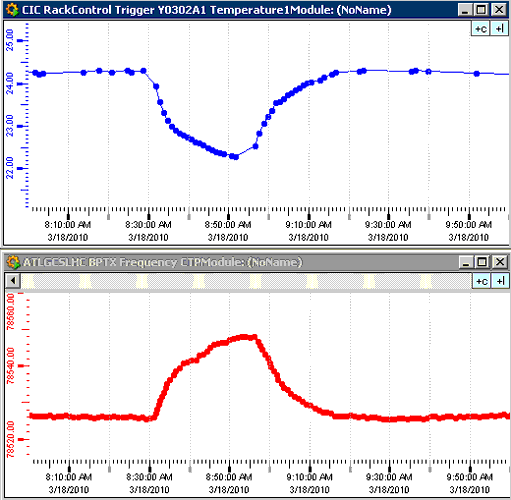
ATLAS e-News
23 February 2011
Precision clockwork
13 April 2010

Distribution of event vertices in the Z direction, measured online in ATLAS. By adjusting the LHC "clock", or the collision point based on the RF frequency "bucket" in which protons are placed, the Z-position of the interaction within ATLAS can be precisely placed.
The combination of precise timing measurements from ATLAS beam pickups with the expertise of the RF group of the LHC, the first 7 TeV collisions happened within 1mm of the exact center of the ATLAS detector, and verified within minutes!
Last time ATLAS e-News caught up with Thilo Pauly, he was busy ‘stress testing’ the ATLAS clock system, to study how the various sub-detectors were able to cope with the kind of clock manipulations foreseen during beam. Once beams started circulating last November, he was able to get on and investigate how ATLAS responds to real changes in the command pulse, which controls all of ATLAS’s electronics like a production line:
“Imagine a row of workers on a conveyer belt. Everyone has to do their one allocated job and every clock tick, the conveyer belt goes one step further,” Thilo explains. “Some subsystems speed up by having increments within that too. The more steps you do in between, the more stable the clock has to be.”
But the clock is not stable. The pulse issued from the LHC’s ‘bunch clock’ at Point 4 speeds up very slightly during the ramping period, along with the frequency of the potential bunches arriving at Point 1. This may only mean a slight frequency increase of 80 Hz (compared with the base frequency of 40 million Hz), but ATLAS is still sensitive to it.
“Not all systems can follow the ramp currently,” says Thilo – a problem that wasn’t apparent from the pre-beam testing. “We’re working very hard to find a solution. It only happens while ATLAS is triggering, so there’s the possibility of masking out the read-out of the problem systems during a ramp.”
Switching back and forth between the main LHC clock and ATLAS’s standby internal clock, for example when the machine teams perform tests which tamper with the LHC clock frequency, is another possible stumbling point. Even if the two are ticking at the same frequency when the switch is made, they may not be in phase and the clashing could throw things into disarray. New software introduced since the summer ensures that all the sub-detectors can now automatically recognise and recover from this problem within a matter of seconds.
The new software is also able to recognise the beam modes of the LHC – such as setup, injection, ramp, flat top, stable beams, and so on – and pick which clock ATLAS should be using at any given time: the external clock when beam is in the machine and an internal clock when the LHC cannot guarantee a stable clock
Switching clocks will ultimately become seamless though, thanks to a new controllable internal clock system that Thilo is setting up. “We tune the internal frequency to the same as the external one, which is measured very precisely,” he explains. “But the clock edges could still be off, so we measure what the difference is and move the internal one such that they look exactly the same. Then we can switch.”
The controllable internal clock, which employs a frequency generator to manipulate the frequency and phase, is a big improvement on its predecessor – a fixed frequency quartz oscillator. Its innate frequency was lower than that of the LHC clock, and the jump between the two was too much for some systems to handle. Not only that; before, the simple act of opening the door to the electronics rack was enough to send systems busy, as the sensitive crystal would expand or contract with changing air temperature, and drift to a different frequency.
Of course, reading the LHC’s clock signal is not a failsafe way to predict the frequency of potential proton bunches as they enter ATLAS. “There’s a lot of electronics in between [the clock at Point 4 and ATLAS] and things can easily get out of sync,” Thilo cautions. BPTX beam pick-ups, which give a direct signal of bunches coming into ATLAS, are used to check how well things are lining up: “It’s a very precise signal in terms of timing, so you can make comparisons with the clock and see whether the clock [the LHC] give you is actually ticking in the same way that the bunches tick in … if there’s a slight drift in phase or frequency, we notice it and then feed back to them.”
The beam pick-ups have also proved their worth as a means of pinpointing where the beams collide longitudinally within ATLAS, via calculations of the time-difference between bunches as they enter opposite ends of the detector. This method is simple and direct, and best of all it works even with unstable beams, when the more precise, but more delicate, tracker is switched off. It’s pretty accurate too; on March 30th, comparison with the tracker showed that it was correct to within a negligible few millimetres. Once every two seconds, the measurement is fed back automatically to the Radio Frequency people at Point 4, who can then play with the pace to control where the beams collide.
“We see every single bunch and we can determine the filling structure. We also get an intensity measurement for free, which is right now as good as the official intensity and sometimes even better. The BPTX is quite a useful little thing!”

The result of opening the door of the LHC electronics rack one morning. The blue trace shows the ambient temperature dropping by about two degrees; the red trace shows the effect this had on the quartz-oscillator clock: the frequency moved up by more than 20 Hz, enough to lose a small fraction of sub-detector data links

Ceri PerkinsATLAS e-NEWS
|